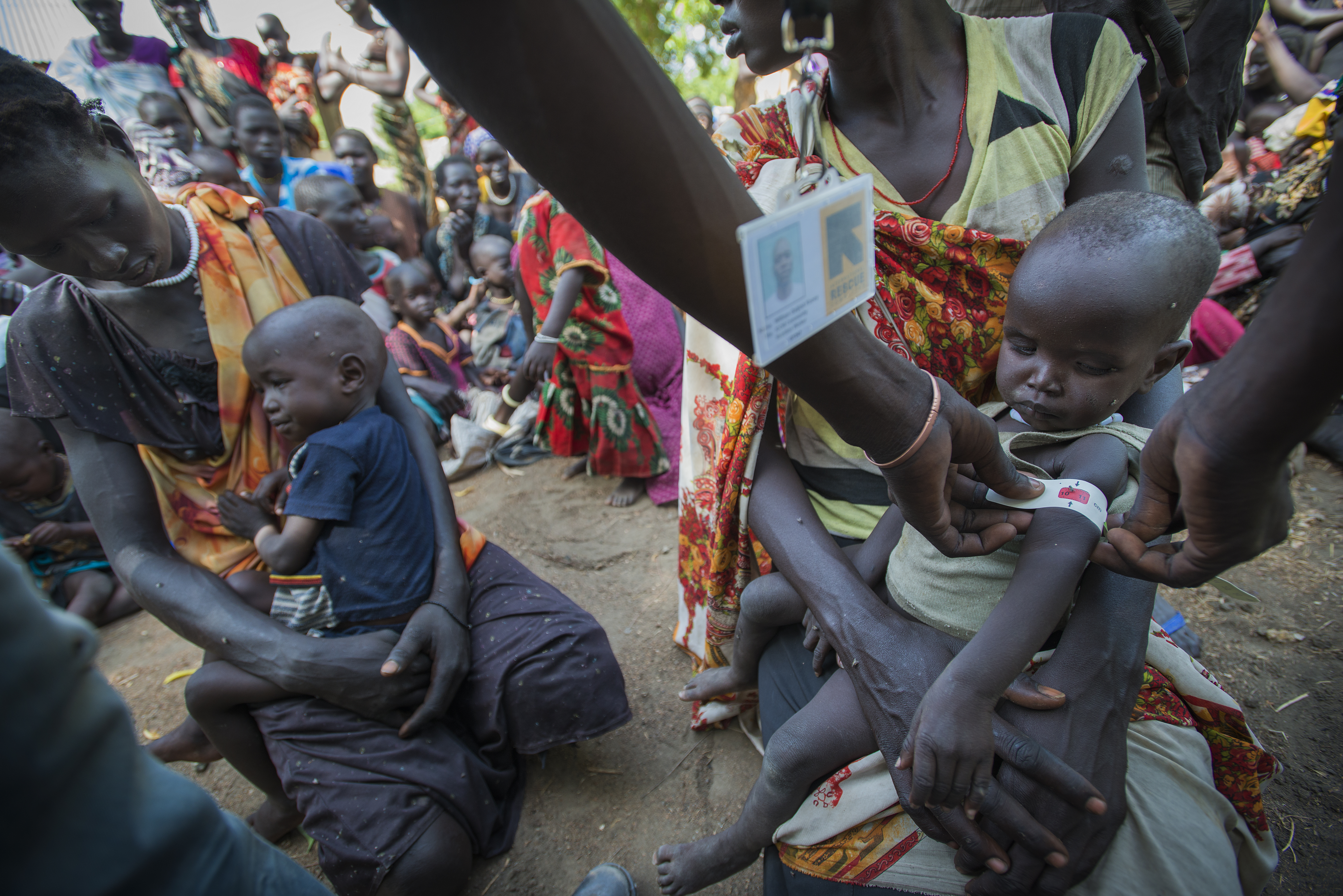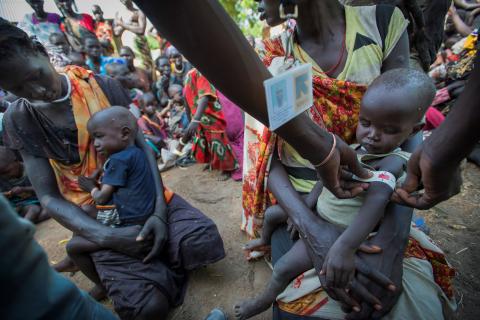Factors affecting decision-making on use of combined/simplified acute malnutrition protocols in Niger, north-east Nigeria, Somalia and South Sudan
Summary of research1
By Naoko Kozuki, Mamadou Seni, Amin Sirat, Omar Abdullahi, Mena Fundi Eso Adalbert, Marie Biotteau, Jeanette Bailey, Amelia Goldsmith and Sarah Dalglish
Naoko Kozuki is the Health Research Adviser for the International Rescue Committee (IRC) and oversees its health research portfolio.
Mamadou Seni is the Nutrition Coordinator for IRC Chad, having been the Senior Nutrition Manager in Niger.
Amin Sirat is the Health and Nutrition Coordinator at IRC Nigeria.
Omar Abdullahi is a project coordinator for the Norwegian Refugee Council in Somalia, having been Health Manager at IRC Somalia.
Mena Fundi Eso Adalbert is the former Nutrition Coordinator at IRC South Sudan.
Marie Biotteau is the Nutrition Technical Advisor at IRC.
Jeanette Bailey is the Senior Advisor for Nutrition Research and Thought Leadership at IRC.
Amelia Goldsmith is an epidemiologist in the Democratic Republic of Congo (DRC) and a graduate of Johns Hopkins Bloomberg School of Public Health
Sarah Dalglish is an Associate at Johns Hopkins Bloomberg School of Public Health.
This project is funded by Elrha’s Research for Health in Humanitarian Crises (R2HC) programme, which aims to improve health outcomes by strengthening the evidence base for public health interventions in humanitarian crises. The programme is funded equally by the Wellcome Trust and the UK Department for International Development (DFID). Visit www.elrha.org/r2hc for more information.
The authors would like to thank IRC’s nutrition technical team and IRC country offices in Niger, Nigeria, Somalia and South Sudan for their support.
Location: Niger, north-east Nigeria, Somalia and South Sudan
What we know: Current guidance and approaches to acute malnutrition management treat severe acute malnutrition and moderate acute malnutrition separately. Combined/simplified approaches are being piloted in several countries.
What this article adds: A policy study was undertaken by the International Rescue Committee to analyse factors affecting decision-making on use of combined/simplified acute malnutrition protocols in Niger, north-east Nigeria, Somalia and South Sudan. Fifty respondents were interviewed from Ministries of Health, United Nations agencies and non-governmental organisations. Simplified protocols are currently implemented in exceptional circumstances in all four contexts. Respondents appreciated the rationale and benefits of combined protocols, but there is reluctance by national governments to depart from global guidelines without stronger evidence and World Health Organization-endorsed global guidance. There is confusion around terminology and concerns regarding implications of mid-upper arm circumference-only programming and ready-to-use therapeutic food supply-chain resourcing and management. Discussions are largely confined to humanitarian circles, largely driven by UNICEF, ECHO and the Nutrition Cluster. Findings highlight opportunities and an urgent need for global research and collaboration around combined protocols to generate scientific evidence and examine implications for health systems.
Introduction
Current guidance and approaches to acute malnutrition management treat severe acute malnutrition (SAM) and moderate acute malnutrition (MAM) separately, despite malnutrition being a spectrum disorder. Recently, the International Rescue Committee (IRC), alongside other global actors, began advocating for simplified, combined protocols to manage both conditions. This policy study sought to analyse factors affecting decision-making surrounding acute malnutrition policies in food-insecure contexts. Niger, north-east Nigeria, Somalia and South Sudan were selected as locations for case studies, each of which are at various stages of discussion on combined/simplified protocols.
Methods
Data collection, carried out between March and August 2018, included semi-structured, in-depth interviews with 50 respondents (N=11-15 per country) from the Ministries of Health, multi-national institutions such as UNICEF and the World Food Programme (WFP), non-governmental organisations (NGOs), and other stakeholders. Eleven global and regional stakeholders were also interviewed to shed light on dynamics impacting national-level policy discussions. Documents such as national policies and guidelines, memos, strategic plans and academic and research reports were also analysed.

Results
Full results will be made available in a future peer-reviewed publication and are summarised here. In all four countries, combined/simplified protocols for management of acute malnutrition have featured in recent policy discussions. National malnutrition protocols in all countries are based on global-level community-based management of acute malnutrition (CMAM)/integrated management of acute malnutrition (IMAM) protocols. The protocols were revised in 2016 in Niger and in 2017 in South Sudan and were undergoing revision in Nigeria and Somalia (as of October 2018).
Terminology around protocols: Only a few respondents were able to clearly define or distinguish between the terms “combined protocol”, “simplified protocol” and “expanded criteria.” Regional and global-level respondents said this confusion stemmed from a lack of coherence at higher policy-making levels.
Implications of adapted protocols: The implications of adopting a combined/simplified protocol varied significantly by country. For national authorities, the gold standard remained World Health Organization (WHO) guidelines, without which it was said to be difficult or impossible to advance discussions. There was generally much more knowledge and appreciation of combined/simplified protocols among external actors than among government authorities. In Niger, national policy-makers rejected a push by partners to introduce mid-upper arm circumference (MUAC)-only diagnosis and remained suspicious of what they saw as an inferior protocol from a clinical perspective. In Somalia and South Sudan, processes for triggering combined/simplified protocols were more systematic. In all countries, current use of combined/simplified protocols was viewed as “exceptional”.
Acceptability of combined/simplified protocols: Specific aspects of combined/simplified protocols were deemed more or less acceptable. There was strong agreement in all countries on providing MAM and SAM treatment at the same location, and specific steps had been taken toward making this an effective rule in Somalia and South Sudan. In Niger and Nigeria, MAM treatment is rarely provided due to funding limitations, leading to concerns about caseload and shifting resources from SAM treatment should a combined protocol be adopted. In all countries, there was poor acceptability of using MUAC as the sole screening measure, due especially to the ‘tall and thin’ morphology of people in Niger, Somalia and South Sudan. There were also strong reservations about the appropriateness of ready-to-use therapeutic foods (RUTF) as the single product because of the shift of significant supply burden from WFP to UNICEF.
Respondents nonetheless appeared to be open to combined/simplified protocols and expressed the view that even sceptical government authorities could be convinced of their appropriateness if presented with scientific evidence. The lack of scientific evidence cited by respondents had to do with clinical effectiveness, operational implications and cost. Pilot projects can move discussions forward, but are not always aligned with national priorities.
Barriers/facilitators to adoption: The main barriers to adopting combined/simplified protocols had to do with the lack of scientific research and validated global guidance, lack of clarity on the conditions under which they are meant to be used, and unclear operational and funding implications. Facilitators to country-level adoption included widespread recognition that current protocols are inefficient, openness to exploring ways to improve these protocols, and awareness of ongoing research studies (Table 1).
Table 1: Barriers and facilitators to adoption of combined/simplified protocols

Drivers of change: The initiative to discuss novel protocols comes from partners: UNICEF and ECHO are the main ‘transfer agents’, alongside Nutrition Clusters. Respondents noted that WHO guidelines motivate changes and updates to national policies.
Complexities of international networks: Respondents reported a good relationship between UNICEF and WFP, but feared the combined protocol could damage this by disturbing their established mandates and suggested discussions are needed at the highest level of these organisations. They also felt there was a lack of coherence in international networks, such as between actors based in the US vs. those based in the UK, and unclear role of coalitions, such as No Wasted Lives. Discussions were confined to humanitarian circles.
Discussion
This research stresses the contextual complexities that contribute to national-level decisions on the adoption of protocol adaptations in food-insecure, emergency contexts. Stakeholders in each country are balancing practical considerations surrounding acute malnutrition treatment, including logistical access, funding and malnutrition burden, against remaining gaps in evidence. There appeared greater resistance to combined/simplified protocols in more stable governments dealing with more localised and/or recent crises (such as Niger and north-east Nigeria) than in less stable contexts with higher physical and food insecurity (Somalia, South Sudan). The challenges described in this study highlight opportunities and urgent need for discussion and collaboration between implementers, funders and researchers around increasing efficiency and effectiveness of current malnutrition treatment protocols and taking into account broader health systems.
For more information, please contact Naoko Kozuki (Principal Investigator).
Endnote
1Full results from this study will be published in a future peer-reviewed publication and summarised in Field Exchange.


